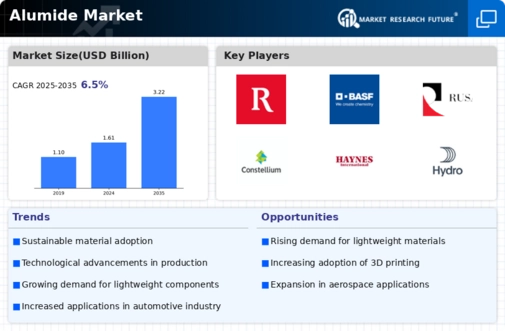Cost-Effectiveness
Cost-effectiveness is emerging as a significant driver in the Alumide Market. As manufacturers seek to optimize production costs while maintaining quality, Alumide presents a compelling option. The combination of aluminum and nylon not only reduces material costs but also minimizes waste during the manufacturing process. Recent studies indicate that companies utilizing Alumide in their production lines can achieve up to a 20% reduction in costs compared to traditional materials. This financial advantage is particularly appealing to small and medium-sized enterprises looking to remain competitive. Additionally, the longevity and durability of Alumide products contribute to lower maintenance and replacement costs over time. As cost pressures continue to influence market dynamics, the Alumide Market is well-positioned to attract businesses seeking efficient and economical material solutions.
Customization Demand
The demand for customization in the Alumide Market is becoming increasingly pronounced. As industries such as automotive, aerospace, and consumer goods evolve, the need for tailored solutions is paramount. Alumide's versatility allows for intricate designs and personalized products, which are essential in meeting specific customer requirements. Recent statistics indicate that the customization market is expected to reach a value of USD 1 trillion by 2026, highlighting the potential for growth in the Alumide sector. This trend is particularly relevant in additive manufacturing, where Alumide is utilized for 3D printing applications. The ability to produce unique, customized parts quickly and efficiently positions the Alumide Market favorably in a competitive landscape, catering to the diverse needs of various sectors.
Technological Innovations
Technological advancements are playing a pivotal role in shaping the Alumide Market. Innovations in 3D printing technologies, particularly in the realm of additive manufacturing, have enhanced the capabilities of Alumide as a material. The introduction of new printing techniques and improved machinery has led to higher precision and efficiency in producing complex geometries. Data suggests that the additive manufacturing market is projected to grow significantly, with a focus on materials like Alumide that offer both strength and flexibility. This evolution in technology not only expands the application range of Alumide but also attracts investment in research and development. As companies seek to leverage these advancements, the Alumide Market is likely to experience increased adoption and integration into various manufacturing processes.
Sustainability Initiatives
The increasing emphasis on sustainability within the Alumide Market is driving demand for eco-friendly materials. As consumers and manufacturers alike prioritize environmentally responsible practices, the adoption of Alumide, which combines aluminum and nylon, is gaining traction. This material is not only lightweight and durable but also recyclable, aligning with the growing trend towards circular economies. According to recent data, the market for sustainable materials is projected to grow at a compound annual growth rate of 10% over the next five years. This shift towards sustainability is likely to influence purchasing decisions, as companies seek to enhance their brand image and meet regulatory requirements. Consequently, the Alumide Market stands to benefit from this trend, as it offers a viable alternative to traditional materials that may not meet sustainability criteria.
Rising Industrial Applications
The expansion of industrial applications is a key driver for the Alumide Market. Industries such as automotive, aerospace, and healthcare are increasingly recognizing the benefits of using Alumide for various components. Its lightweight nature, combined with high strength and durability, makes it an attractive option for parts that require both performance and efficiency. Recent market analysis indicates that the automotive sector alone is expected to account for a substantial share of the Alumide Market, driven by the need for lightweight materials to improve fuel efficiency. Furthermore, the healthcare industry is exploring Alumide for medical devices and equipment, where precision and reliability are critical. This diversification of applications is likely to propel the growth of the Alumide Market, as it adapts to meet the evolving needs of different sectors.

















Leave a Comment